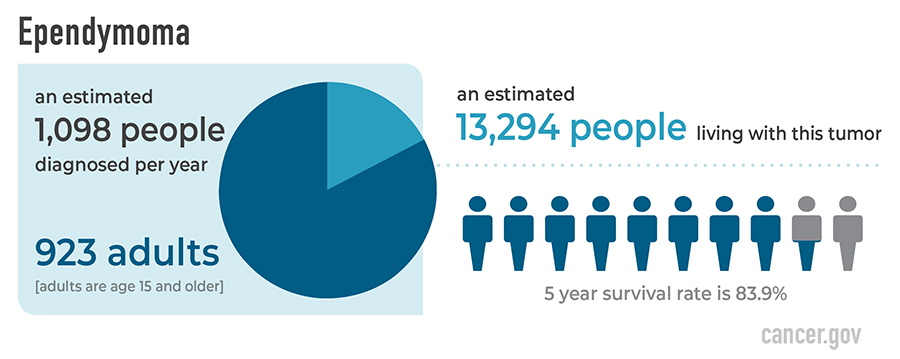.__v300149388.jpg)
MRI of an ependymoma in the spine. Credit: NCI-CONNECT Staff
An ependymoma is a primary central nervous system (CNS) tumor. This means it begins in the brain or spinal cord.
What are the grades of ependymomas?
Ependymomas are grouped in three grades based on their characteristics. Within each grade, are different ependymoma subtypes. Molecular testing is used to help identify subtypes that are related to location and disease characteristics.
- Grade I ependymomas are low grade tumors. This means the tumor cells grow slowly. The subtypes include subependymoma and myxopapillary ependymoma. Both are more common in adults than in children. Myxopapillary tumors usually occur in the spine.
- Grade II ependymomas are low grade tumors and can occur in either the brain or the spine.
- Grade III ependymomas are malignant (cancerous). This means they are fast-growing tumors. The subtypes include anaplastic ependymomas. These most often occur in the brain, but can also occur in the spine.
Who is diagnosed with ependymomas?
Ependymomas occur in both children and adults. Ependymomas in the lower half of the brain are more common among children. Ependymomas in the spine are more common among adults. Ependymomas occur slightly more often in males than females.

.__v300151430.jpg)
Patient Experience with Rare Tumor
What causes ependymomas?
The cause of ependymomas is not known.
Where do ependymomas form?
Ependymomas can form anywhere in the CNS. Ependymomas often occur near the ventricles in the brain and the central canal of the spinal cord. On rare occasions, ependymomas can form outside the CNS, such as in the ovaries. Ependymomas develop from ependymal cells (called radial glial cells). Ependymal cells are one of three types of glial cells that support the CNS.
Do ependymomas spread?
Ependymomas rarely spread outside the CNS. But ependymomas can spread to other areas of the CNS through cerebrospinal fluid (CSF).
What are symptoms of an ependymoma?
Symptoms related to an ependymoma depend on the tumor’s location. People with an ependymoma in the brain may have headaches, nausea, vomiting and dizziness. People with an ependymoma in the spine may have back pain, numbness and weakness in their arms, legs or trunk, problems with sexual, and urinary or bowel problems.
What are treatment options for ependymomas?
.__v200194558.jpg)
NCI Presentations at SNO
Read a synopsis of the NCI-CONNECT presentations at the 2018 Annual Meeting of the Society for Neuro-Oncology.
The first treatment for an ependymoma is surgery, if possible. The goal of surgery is to obtain tissue to determine the tumor type and to remove as much tumor as possible without causing more symptoms for the person.
After surgery, there is no standard treatment for ependymomas. Many people won’t need other treatment after surgery. For other people, treatments may include radiation, chemotherapy or clinical trials. Clinical trials, with new chemotherapy, targeted therapy, or immunotherapy drugs, may also be available and can be a possible treatment option. Treatments are decided by the patient’s healthcare team based on the patient’s age, remaining tumor after surgery, tumor type, and tumor location.
What do ependymomas look like on an MRI?
Ependymomas usually appear as a well-defined mass that often brightens with contrast.
Posted: September 17, 2018
This content is provided by the National Cancer Institute (www.cancer.gov)